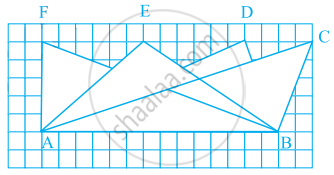Advertisements
Advertisements
Question
If the points P(–3, 9), Q(a, b) and R(4, – 5) are collinear and a + b = 1, find the values of a and b.
Solution
The given points are P(–3, 9), Q(a, b) and R(4, –5).
Since the given points are collinear, the area of triangle PQR is 0.
∴1/2[x1(y2−y3)+x2(y3−y1)+x3(y1−y2)]=0
Here, x1=−3, y1=9, x2=a, y2=b and x3=4, y3=−5
∴1/2[−3(b+5)+a(−5−9)+4(9−b)]=0
⇒−3b−15−14a+36−4b=0
⇒−7b−14a+21=0
⇒2a+b=3 ...(1)
Given:
a+b=1 ...(2)
Subtracting equation (2) from (1), we get:
a = 2
Putting a = 2 in (2), we get:
b = 1 − 2 = − 1
Thus, the values of a and b are 2 and −1, respectively.
APPEARS IN
RELATED QUESTIONS
If the points A(x, 2), B(−3, −4) and C(7, − 5) are collinear, then the value of x is:
(A) −63
(B) 63
(C) 60
(D) −60
The vertices of ∆ABC = are A (4, 6), B(1, 5) and C(7, 2). A line is drawn to intersect sides AB and AC at D and E respectively such that `\frac{AD}{AB}=\frac{AE}{AC}=\frac{1}{4}` .Calculate the area of ∆ADE and compare it with the area of ∆ABC
If A(4, –6), B(3, –2) and C(5, 2) are the vertices of ∆ABC, then verify the fact that a median of a triangle ABC divides it into two triangle of equal areas.
In each of the following find the value of 'k', for which the points are collinear.
(7, -2), (5, 1), (3, -k)
Find the area of the triangle formed by joining the mid-points of the sides of the triangle whose vertices are (0, -1), (2, 1) and (0, 3). Find the ratio of this area to the area of the given triangle
Find the area of the following triangle:

Find the area of the following triangle:

If the sides of a triangle are 3 cm, 4 cm and 5 cm, then the area is
Find the value of m if the points (5, 1), (–2, –3) and (8, 2m) are collinear.
Observe all the four triangles FAB, EAB, DAB and CAB as shown in the given figure.

- All triangles have the same base and the same altitude.
- All triangles are congruent.
- All triangles are equal in area.
- All triangles may not have the same perimeter.
